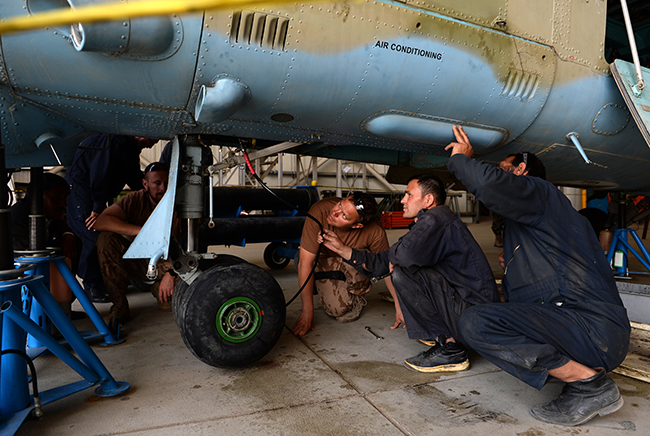
Afghan air force maintainers, along with coalition members, repair landing gear on an Mi-35 helicopter at Kabul Air Wing, Afghanistan, on June 4, 2015. Air Force photo by SSgt. Sandra Welch.
The Pentagon is trying to get the Afghan Air Force to dump its Russian-built Mi-35 attack helicopters to instead focus on American-made aircraft, even as the growing military received four more of the rotorcraft from India last year.
In a semiannual Defense Department report published July 12 that covers December 2018 through May 2019, officials noted they have advised the Afghans to abandon the Mi-35 HIND maintenance program, for which the US doesn’t offer funding or advisory support. The Indian Air Force advises the Afghans on the aircraft.
“The Mi-35s were removed from the authorized fleet in 2015 but the Afghans continue to attempt to sustain them,” according to the congressionally mandated report. “DOD has advised them against doing so and to instead focus on the aircraft that DOD is providing as a part of the aviation modernization program.”
The US Air Force trains Afghan pilots and maintainers whose inventory of more than 160 aircraft includes the fixed-wing C-130, C-208, AC-208, and A-29, as well as the rotary-wing Mi-17, MD-530, UH-60A variants, and the Mi-35. About 125 of those are in Afghanistan and readily available or undergoing short-term maintenance.
Afghanistan owns 10 more US-supported airframes than it did in the second half of 2018, and the number of qualified pilots and copilots rose by about a dozen in December 2018 to 222 this month.
“Understaffed crew positions, like flight engineers, that the AAF [requires] to assemble fully trained flight crews limit some aircraft platforms,” the recent report added. “Under the aviation modernization program, DOD is delivering two UH-60A+s per month and five armed MD-530s per quarter to the [Ministry of Defense] until program objectives are met.”
Mi-35s are not included in DOD’s total inventory count because the US removed it from the list of “authorized” airframes. The report says the Afghans seek funding to finish repairing the fleet.
India has shipped eight Mi-35s to the AAF so far, including four last year and four in 2015-2016.
“This aid marks a significant departure from India’s previous policy of providing only non-lethal military assistance,” the report stated. “Pakistani sensitivities towards Indian involvement in the country ultimately limited the assistance.”
DOD indicated India could remain invested in curbing the Taliban’s resurgence even if the US pulls troops out of the country. Indian efforts may also rebuff regional influence from Russia, which provides limited materiel support to the Taliban.
“In the event of a US drawdown in Afghanistan, India likely will attempt to continue its support to Afghanistan and try to limit Taliban, Pakistani, and Chinese influence,” the report stated. “A significant deterioration of security conditions in Afghanistan, however, may adversely affect the ability of India to provide aid.”
For years, the Pentagon has worked to build Afghanistan’s military into a self-sufficient force that can fight insurgencies and defend its own borders in the post-9/11 era—even as the local Islamic State of Iraq and Syria offshoot gains territory in eastern Afghanistan and al-Qaida collaborates with the Taliban.
The AAF is making incremental progress despite lacking effective leadership, DOD said. It now wields laser-guided bombs on its A-29s, can fly nighttime missions in that airframe, and can airdrop supplies using the C-208. Afghan airmen make up 18 detachments and three wings.
“The AAF continues to show steady improvement in pilot skill, ground crew proficiency, and air-to-ground integration,” according to the Pentagon report. “The AAF can independently plan for and provide air assets for logistics, resupply, humanitarian relief efforts, return of human remains, [medical evacuation], casualty evacuation, non-traditional [intelligence, surveillance, and reconnaissance], air interdiction, close air attack, armed overwatch, and aerial escort missions.”
While the report argues the Afghan National Defense and Security Forces are improving at counterinsurgency operations and retaining a growing number of members, it found an “enduring terrorist threat” will require the US, international partners, and the Afghan military to “maintain a robust [counterterrorism] capability for the foreseeable future.”
